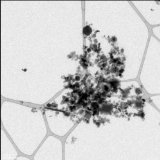Magnesium oxide Compounds
Magnesium Oxide is a highly insoluble thermally stable Magnesium source suitable for glass, optic and ceramic applications. Magnesium oxide is a hygroscopic white powder that forms magnesium hydroxide in the presence of water, it was historically known as magnesia alba (white mineral from Magnesia). Oxide compounds are not conductive to electricity.  However, certain perovskite structured oxides are electronically conductive finding application in the cathode of solid oxide fuel cells and oxygen generation systems. They are compounds containing at least one oxygen anion and one metallic cation. They are typically insoluble in aqueous solutions (water) and extremely stable making them useful in ceramic structures as simple as producing clay bowls to advanced electronics and in light weight structural components in aerospace and electrochemical applications such as fuel cells in which they exhibit ionic conductivity. Metal oxide compounds arebasic anhydrides and can therefore react with acids and with strong reducing agents in redox reactions. See Nanotechnology for more nanotechnology applications information. Magnesium Oxide is also available in pellets, pieces, powder, sputtering targets, tablets, and nanopowder (from American Elements' nanoscale production facilities). Magnesium Oxide is generally immediately available in most volumes. Ultra high purity, high purity, submicron and nanopowder forms may be considered. Additional technical, research and safety (MSDS) information is available.
However, certain perovskite structured oxides are electronically conductive finding application in the cathode of solid oxide fuel cells and oxygen generation systems. They are compounds containing at least one oxygen anion and one metallic cation. They are typically insoluble in aqueous solutions (water) and extremely stable making them useful in ceramic structures as simple as producing clay bowls to advanced electronics and in light weight structural components in aerospace and electrochemical applications such as fuel cells in which they exhibit ionic conductivity. Metal oxide compounds arebasic anhydrides and can therefore react with acids and with strong reducing agents in redox reactions. See Nanotechnology for more nanotechnology applications information. Magnesium Oxide is also available in pellets, pieces, powder, sputtering targets, tablets, and nanopowder (from American Elements' nanoscale production facilities). Magnesium Oxide is generally immediately available in most volumes. Ultra high purity, high purity, submicron and nanopowder forms may be considered. Additional technical, research and safety (MSDS) information is available.
Magnesium (atomic symbol: Mg, atomic number: 12) is a Block S, Group 2, Period 3 element with an atomic mass of 24.3050. The number of electrons in each of Magnesium's shells is [2, 8, 2] and its electron configuration is [Ne] 3s2. The magnesium atom has a radius of 160 pm and a Van der Waals radius of 173 pm. Magnesium was discovered by Joseph Black in 1775 and first isolated by Sir Humphrey Davy in 1808. Magnesium is the eighth most abundant element in the earth's crust and the fourth most common element in the earth as a whole. In its elemental form, magnesium has a shiny grey metallic appearance and is an extremely reactive. It is can be found in minerals such as brucite, carnallite, dolomite, magnesite, olivine and talc. Commercially, magnesium is primarily used in the creation of strong and lightweight aluminum-magnesium alloys, which have numerous advantages in industrial applications. The name "Magnesium" originates from a Greek district in Thessaly called Magnesia. For more information on magnesium, including properties, safety data, research, and American Elements' catalog of magnesium products, visit the Magnesium element page.
You might also like



|
Magnesium Oxide Crystal Powder, 0.1-174um, 99.94%, 25g, High Surface Area, by GalliumSource, LLC BISS (GalliumSource, LLC)
|



|
Formation of a compact oxide layer on AZ91D magnesium alloy by microarc oxidation via addition of cerium chloride into the MAO electrolyte.(Report): An article from: JCT Research Book (American Coatings Association, Inc.) |
|
|
Naturo Nitro Pre Workout Octane - Maximize Your Training with Massive Muscle Building Power for Any Fitness Level! Ignites a Body Building Construction Project with Every Workout - A Precision Formulated, Preworkout Performance Blend of Select Amino Acids Teams with a Vein-bulging, Triple-action Creatine Blend to Drive Your Muscle Gain and Workout Results to the Extreme - With Naturo Nitro Octane, Your Pre-workout Is Super Charged with a Proprietary, Jungle Crazed Energy and Focus Blend Combining Eight of Nature's Premier, Energy Accelerating Compounds, 28 Servings Pink Lemonade Health and Beauty (Naturo Sciences)
|





